

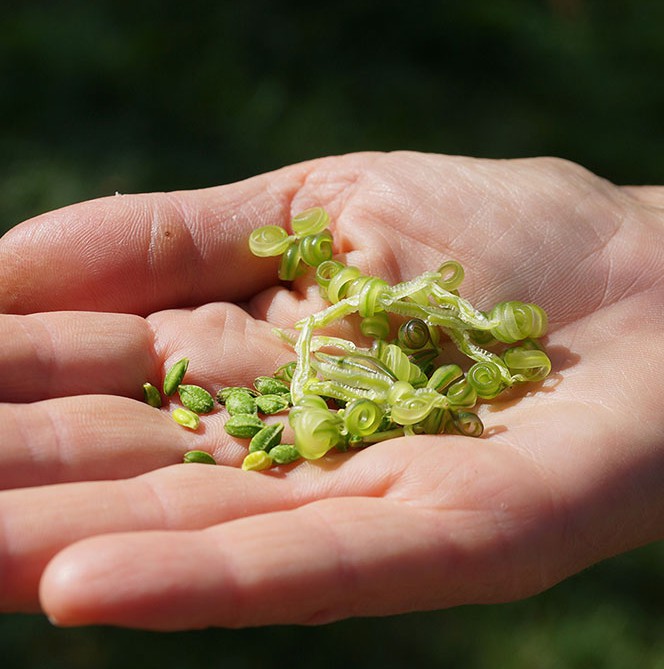 Why wild-type seeds
Why wild-type seedsAt Wild Seed Project, we advocate for the propagation of wild-type native plants. Today, many commercial nurseries favor cultivars and hybrids, garden varieties that have been domesticated and bred to have characteristics such as dwarfism, specific flower color, double flowers and uniformity of growth. These traits may look nice to people, but they often lack reproductive ability or the genetic diversity that is necessary to adapt to changing environmental conditions. To perpetuate these traits, nurseries must reproduce these plants by cloning, that is without sexual reproduction.
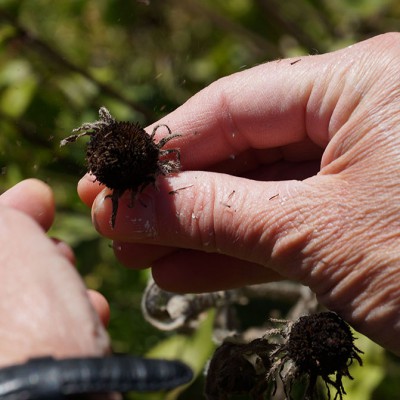 In the wild, most plants reproduce sexually, in other words, from seed. Sexual reproduction results in variation between individual plants, as any single plant adapts differently in its ability to cope with environmental stress such as heat, drought, flooding and other disturbances. Genetic variation is a species’ best strategy for adapting to future environmental conditions, and seed propagation maintains the genetic diversity inherent in wild native plants.
In the wild, most plants reproduce sexually, in other words, from seed. Sexual reproduction results in variation between individual plants, as any single plant adapts differently in its ability to cope with environmental stress such as heat, drought, flooding and other disturbances. Genetic variation is a species’ best strategy for adapting to future environmental conditions, and seed propagation maintains the genetic diversity inherent in wild native plants.
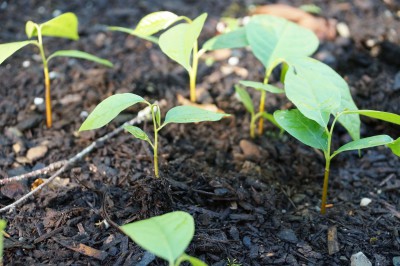 One of the joys of propagating native plants is that you don’t need expensive or sophisticated facilities. Native seeds are ideally suited to germinate outdoors in beds or pots. For many native plants, germination outdoors is often better than when seeds are sown in a greenhouse where the temperature is too consistent and high humidity creates perfect conditions for rot. With outdoor propagation, seeds germinate when the conditions are optimum for each species. For some, that’s in the frosty temperatures of early spring and others in the heat of summer.
One of the joys of propagating native plants is that you don’t need expensive or sophisticated facilities. Native seeds are ideally suited to germinate outdoors in beds or pots. For many native plants, germination outdoors is often better than when seeds are sown in a greenhouse where the temperature is too consistent and high humidity creates perfect conditions for rot. With outdoor propagation, seeds germinate when the conditions are optimum for each species. For some, that’s in the frosty temperatures of early spring and others in the heat of summer.
Seeds can be sown in seed flats or plastic pots 4’’- 10” in diameter and 3” or more deep and tucked into a shady spot. For the home gardener, 10 – 20 pots can be set up under a garden bench. It is out of the traffic of dogs and children, shady and looks tidy. An uncovered cold frame also makes a good nursery area for seed flats and pots. It is just as easy to care for a dozen pots as it is one, and you are sure to have some good success if you try growing a variety of species. If you don’t need all the plants, they can be shared with others. (See below for directions on how to build an in-ground seed propagation bed.)
Native seeds can be sown thickly (planted close together). Label with the name and sowing date. A good rule of thumb is to sow the seeds to the depth of the thickness of the seed and roughly 1/8 to ¼ inch apart. Seeds that are fine and dust-like are barely covered (if at all, see germination codes below). After sowing, cover the seeds with coarse sand, which is preferable to potting soil as the sand helps keep the seeds from splashing out in the rain. If nearby weeds are a concern, cover flats with a spun poly covering such as Reemay. Keep watered, usually every couple of days to a week.
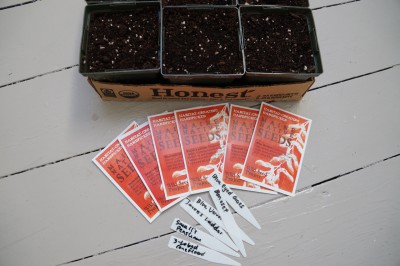
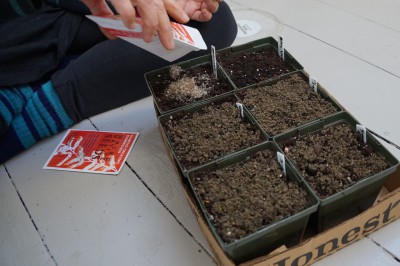
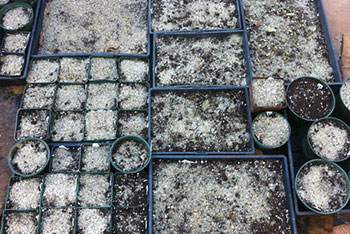
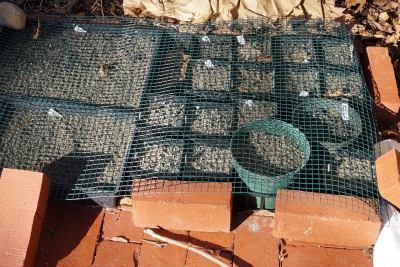
Each native seed has its own timetable for germination. This is very different from cultivated plants such as vegetables and annual flowers who have been bred and selected for rapid germination. In wild plants, seed germination is often variable. Some seeds will germinate immediately while others germinate irregularly over a period of weeks, months or even years. This reproductive strategy is advantageous for a wild plant because offspring are dispersed over time, a better strategy for dealing with the climatic fluctuations.
Seeds that need no pretreatment will germinate anytime from a week to several months after sowing. Species which need a winter stratification and will germinate when the seed dormancy is overcome at the time appropriate to each species. Flats that fail to germinate initially will often germinate the following year. Don’t throw them out, be patient.
All seeds can be sown and placed outdoors in fall or winter bypassing the need for an artificial indoor cold stratification (refrigerator) required for some species when planted in spring. This is the simplest method.
The following germination codes, which correspond to those on WSP seed packages, will give you an indication of which treatment your specific species needs.
Germination code A – Seeds can be sown outdoors in fall or early spring.
Aster, columbine, milkweed, lobelia, coneflower, campanula, wild strawberry, jack-in-the-pulpit, wintergreen, fern spores, spirea, sweet-pepperbush, buttonbush, bush-honeysuckle, rhododendron, St. Johnswort
Germination code B – Seeds need a winter or cold period to germinate. Sow outdoors in fall or winter.
Iris, vervain, blue-eyed grass, alliums, boneset, geranium, Joe-Pye weed, bunchberry, beardtongue, blazing star, violet, aronia, spicebush, bayberry, rose, wild plum, shrub dogwoods, serviceberry, elderberry
Germination code C – Seeds need light to germinate; sow on soil surface and leave uncovered.
All tiny, dust-like seeds
Germination code D – Seeds need alternating cycles of warm-to-cold-to-warm to germinate. They can be sown either outdoors in spring or summer and will germinate the following year, or in a flat in a warm place for three months, then moved to a refrigerator for two months, then moved outside in the early summer warmth.
Canada, turk’s cap, and wood lilies; black bugbane (aka black cohosh), viburnum
Germination code E – Seeds cannot be allowed to dry out. Sow immediately.
Pussy willow, bloodroot, marsh-marigold, trillium, wild ginger, bellwort, blue-bead lily; nuts: oak, hickory, butternut, hazelnut, and walnut
Germination code F – Seeds take two years to germinate. Sow outside in the fall or winter and look for germination in the second spring. A shady location prevents the flats from rapid drying and reduces weeding.
Trillium, wild ginger, solomon’s-seal, bellwort, blue-bead lily, Canada-mayflower, false solomon’s-seal, viburnum, witch-hazel, basswood
Germination code G – Large seeds should be soaked overnight in water.
Seeds over 1/4” in diameter (Iris, witch hazel, oak, acorn, hickory, cherry)

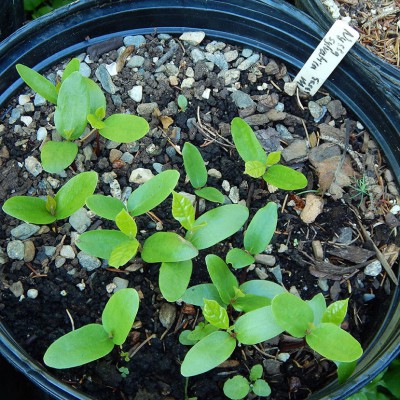
NOTE: If you find yourself with seeds that need a cold period and it’s late spring, you can still sow the seeds by giving them an artificial winter. Wrap the flat in plastic or sow the seeds in moistened sand or vermiculite and seal in a zip lock bag, record the date, and put in the refrigerator for 60 days. Remove after the simulated winter and put flat outside.
Many native seedlings can stay in the original flat for the first growing season. If the seedlings seem overly crowded, they can be gently divided and potted the first summer. Otherwise, wait until the following spring to transplant seedlings to their new home. Don’t forget to keep the plants labeled. When transplanting, clump 3-10 seedlings together per pot (unless it’s a tree species). This ensures that there is more than one individual; the new planting will have some genetic diversity and be able to produce viable seed. A diluted liquid seaweed fertilizer every other week will keep seedlings healthy and strong.
 Overwintering Seedlings and Protecting Nursery Area from Rodents
Overwintering Seedlings and Protecting Nursery Area from RodentsGerminated pots and flats need winter protection from weather extremes and windburn, just as a consistent snow cover supplies to a garden. Multiple layers of a winter-grade Reemay covered with white plastic works well. The plants should be frozen before covering, otherwise rodents may choose your covered nursery as a perfect nest site.
A germination bed has the advantage of needing less watering than flats or pots, and the seedlings can grow to a bigger size before transplanting.
Chose a location in full to part shade for woodland species, part shade for most other species, with the exception of full sun for plants that need dry, sunny conditions.
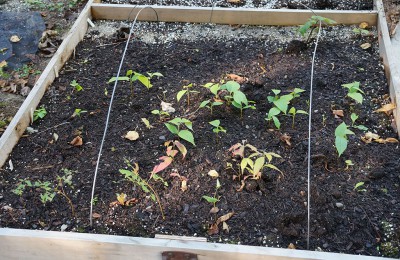 Make a frame out of rough-cut 2” x 10” or 2” x 12” lumber (not pressure treated, it releases too many nasty chemicals). A four foot-wide by ten foot-long bed will hold a lot of seedlings for several years. You can also use logs that are 6 – 10” in diameter. Staple some heavy-gage screening to the bottom, flip over, and set in place. Fill with a weed-free compost-based potting mix. You can create your own growing medium by mixing 3 parts weed-free compost or leaf mold, 1 part vermiculite, and 1 part coarse builders’ sand. The compost and leaf mold will contain lots of beneficial microorganisms and slowly release nutrients over time, unlike a peat moss based potting soil that is sterile and deprived of nutrients.
Make a frame out of rough-cut 2” x 10” or 2” x 12” lumber (not pressure treated, it releases too many nasty chemicals). A four foot-wide by ten foot-long bed will hold a lot of seedlings for several years. You can also use logs that are 6 – 10” in diameter. Staple some heavy-gage screening to the bottom, flip over, and set in place. Fill with a weed-free compost-based potting mix. You can create your own growing medium by mixing 3 parts weed-free compost or leaf mold, 1 part vermiculite, and 1 part coarse builders’ sand. The compost and leaf mold will contain lots of beneficial microorganisms and slowly release nutrients over time, unlike a peat moss based potting soil that is sterile and deprived of nutrients.
Seeds can be sown in 4’ rows across this bed and marked with long-lasting plastic label. If there is a nearby source of weeds such as an old field or dandelion strewn lawn, cover bed with Reemay.
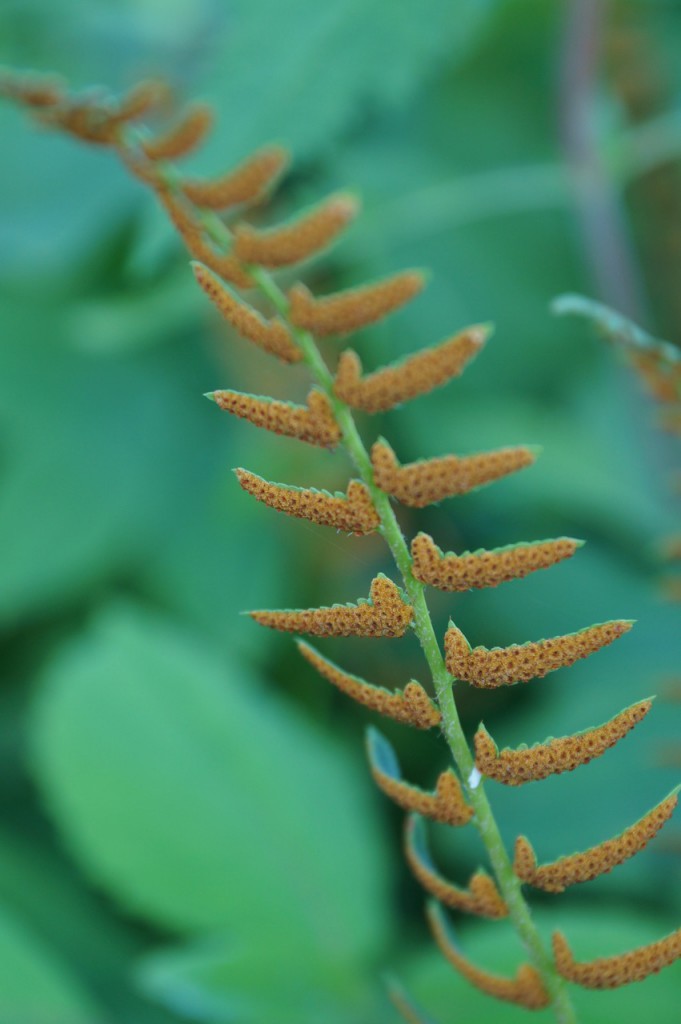 Ferns are ancient plants whose ancestors first appeared on Earth over 300 million years ago. They are members of a group of primitive plants called Pteridophytes, which dominated the land before the rise of flowering plants. During the age of the dinosaurs, ferns and other primitive plants such as club mosses and horsetails reached magnificent proportions, many over 100 feet tall. This period of the Earth’s history had a global climate of warm temperatures and high humidity, ideal conditions for Pteridophytes to flourish.
Ferns are ancient plants whose ancestors first appeared on Earth over 300 million years ago. They are members of a group of primitive plants called Pteridophytes, which dominated the land before the rise of flowering plants. During the age of the dinosaurs, ferns and other primitive plants such as club mosses and horsetails reached magnificent proportions, many over 100 feet tall. This period of the Earth’s history had a global climate of warm temperatures and high humidity, ideal conditions for Pteridophytes to flourish.
Ferns have a unique reproductive strategy involving two distinct phases in their life cycle: the mature fern and the prothallia. Sometime during the growing season, a mature fern releases spores, which are the plants sexually reproductive cells. With adequate moisture and light, these spores begin to grow and form small flat plants called prothallia, the second phase in the lifecycle. Reproductive organs develop on the prothallia. If fertilization occurs, the egg cell grows into a sporophyte (young fern), and the lifecycle of a new fern begins again.
Fern spores can be propagated indoors in a bright windowsill out of direct sunlight or under a light. You will need some sterile, peat-based potting soil that has been moistened with boiling water and cooled off, water in a misting bottle (that has also been boiled and cooled), and a new clear plastic deli container. Spores are sown inside the container, and if not sterilized, mold or algae can take over. In nature, ferns often germinate in moss, a rotting log, or damp exposed soil in shady locations such as by a stream.
Fill the clear plastic container ½ full with moistened potting soil and quickly replace the lid. With fern spores at the ready, open the lid and carefully sprinkle a light dusting of spores over the soil surface, much as you would season food by hand with a pinch of salt. Lightly mist, and put container in a warm, bright location without direct sunlight or under lights. Check for germination over the next couple of weeks or longer. Do not open the container unless you think the soil is dry, in which case you should water lightly with the mister.
At first, germination will look like a green coating on the soil surface. Next small flat green prothallia will appear; this is when sexual reproduction occurs. After a month or more, you will see little fern fronds. This means that you have successfully passed from the reproductive phase to a juvenile fern. At this point you should remove the lid. Keep plants regularly watered but do not overwater or the plants could rot. Fertilizing with a very weak seaweed fertilizer will eventually be necessary. Small ferns—one inch tall—can be repotted in a good organic compost-based potting soil. In early summer, move the pots outdoors into the shade to adjust to the natural growing season. They can be planted in the garden in late summer or early fall.
For more detailed information on growing ferns, consult Native Ferns, Moss and Grasses by William Cullina.